Blast Fragment Impact of Angle-Ply Composite Structures for Buildings Wall Protection
Abstract
:1. Introduction
2. Experimental Procedures
2.1. Materials
2.2. Sample Development
2.3. Impact Testing
3. Results and Discussion
3.1. Impact Tests—The Effect of Fragments
3.2. Impact Tests—The Effect of the Angle-Ply Structure
3.3. Impact Tests—The Effect of the Type of Fiber
4. Conclusions
Author Contributions
Funding
Data Availability Statement
Acknowledgments
Conflicts of Interest
References
- Zhu, H.; Wang, X.; Wang, Y.; Ji, C.; Wu, G. Damage ehaviour and assessment of polyurea sprayed reinforced clay brick masonry walls subjected to close-in blast loads. Int. J. Impact Eng. 2022, 167, 104283. [Google Scholar] [CrossRef]
- Taha, A.; Zahran, M.; Gao, Z. Mitigation of the blast load effects on a building structure using newly composite structural configurations. Def. Technol. 2021, 17, 75–84. [Google Scholar] [CrossRef]
- Chen, G.; Lu, J.; Wu, H. Dynamic beahvior and retrofitting of RC frame building under vehicular bomb explosion. Eng. Fail. Anal. 2023, 143. [Google Scholar] [CrossRef]
- Grisaro, H.; Benamou, D.; Dancygier, A. Effects of fragments impact on reinforced concrete protective elements. Procedia Eng. 2017, 210, 306–311. [Google Scholar] [CrossRef]
- Nilakantan, G.; Nutt, S. Effects of fabric target shape and size on the V50 ballistic impact response of soft body armor. Compos. Struct. 2014, 116, 661–669. [Google Scholar] [CrossRef]
- Wang, L. Recent Trends in Ballistic Protection. Text. Light Ind. Sci. Technol. 2014, 3, 37–47. [Google Scholar] [CrossRef]
- Farias-Aguilar, J.C.; Ramírez-Moreno, M.J.; Gonzalez-García, D.M. Evoluation of the ballistic protection level of (glass-fiber reinforced polyamide 6)-aramide fabric sandwich composite panels. J. Mater. Res. Technol. 2021, 12, 1606–1614. [Google Scholar] [CrossRef]
- Bhat, A.; Naveen, J.; Jawaid, M.; Norrrahim MN, F.; Rashedi, A.; Khan, A. Advancement in fiber reinforced polymer, metal alloys and multi-layered armour systems for ballitic applications—A review. J. Mater. Res. Technol. 2021, 15, 1300–1317. [Google Scholar] [CrossRef]
- Marissen, R.; Smit, L.; Snijder, C. Dyneema fibers in composites, the addition of special mechanical functionalities. In Proceedings of the Advancing with Composites 2005, International Meeting on Composite Materials, Napels, FL, USA, 11–14 October 2005. [Google Scholar]
- Saleem, I.A.; Ahmed, P.S.; Abed, M.S. Experimental and numerical investigation of Kevlar and UHMWPE multi-layered armors against ballistic impact. Mater. Today Proc. 2021, 56, 2516–2524. [Google Scholar] [CrossRef]
- Steinke, K.; Sodano, H.A. Improved inter-yarn friction and ballistic impact performance of zinc oxide nanowire coated ultra-high molecular weight polyethylene (UHMWPE). Polymer 2021, 231, 124125. [Google Scholar] [CrossRef]
- Abtew, M.A.; Boussu, F.; Bruniaux, P.; Loghin, C. Ballistic impact mechanisms—A review on textiles and fibre-reinforced composites impact responses. Compos. Struct. 2019, 223, 110966. [Google Scholar] [CrossRef]
- Karthikeyan, K.; Russel, B.P.; Fleck, N.A.; Wadley, H.N.G.; Deshpande, V.S. The effect of shear strenght on the ballistic response of laminated composite plates. Eur. J. Mech. A Solids 2013, 42, 35–53. [Google Scholar] [CrossRef]
- Cheeseman, B.; Bogetti, T. Ballistic impact into fabric and compliant composite laminates. Compos. Struct. 2003, 61, 161–173. [Google Scholar] [CrossRef]
- Cunniff, P. An analysis of the System Effects in Woven Fabrics Under Ballistic Impact. Text. Res. J. 1992, 62, 495–507. [Google Scholar] [CrossRef]
- Bohong, G. Analytical modeling for the ballistic perforation of planar plain-woven fabric target by projectile. Compos. Part B 2003, 34, 361–371. [Google Scholar]
- Martínez-Hergueta, F.; Ridruejo, A.; González, C.; LLorca, J. Ballistic performance of hybrid nonwoven/woven polyethylene fabric shields. Int. J. Impact Eng. 2017, 111, 55–65. [Google Scholar] [CrossRef]
- Dias, D. Comportamento ao Impacto a Baixa Velocidade de Laminados de Epóxido/Fibra de Vidro, com Camadas de Cortiça; Faculdade de Engenharia da Universidade do Porto: Porto, Portugal, 2009. [Google Scholar]
- Grujicic, M.; Arakere, G.; He, T.; Bell, W.C. Multi-scale ballistic material modeling of cross-plied compliant composites. Compos. Part B 2009, 40, 468–482. [Google Scholar] [CrossRef]
- O’Masta, M.R.; Deshpande, V.S.; Wadley, H.N.G. Mechanisms of projectile penetration in Dyneema encapsulated aluminum structures. Int. J. Impact Eng. 2014, 74, 16–35. [Google Scholar] [CrossRef]
- Arora, S.; Majumdar, A.; Butola, B. Soft armour design by angular stacking of shear thickening, fluid impregnated high-performance ferics for quasi-isotropic ballistic responde. Compos. Struct. 2020, 223, 10–20. [Google Scholar]
- Khaire, N.; Tiwari, G.; Iqbal, M.A. Effect of eccentricity and obliquity on the ballistic performance and energy dissipation of hemispherical shell subjected to ogive nosed. Thin-Walled Struct. 2021, 161, 107447. [Google Scholar] [CrossRef]
- Wong, W.; Horsfall, I.; Champion, S.M.; Watson, C.H. The Effect of Matrix Type on The Ballistic and Mechanical Performance of E-glass Composite Armour; U.K. Engineering Systems Department, Royal Military College of Science: Shrivenham, UK, 2001. [Google Scholar]
- Zhang, Q.; Qin, Z.; Yan, R.; Wei, S. Processing technology and ballistic-resistant mechanism of shear thickening fluid/high-performance fiber-reinforced composites: A review. Compos. Struct. 2021, 266, 113806. [Google Scholar] [CrossRef]
- Zhou, H.; Min, S.; Chen, X. A numerical study on the influence of quai-isotropic structures on the ballistic performance of para-aramid woven composites. Compos. Struct. 2021, 275, 114489. [Google Scholar] [CrossRef]
- Shengnan, M.; Yanyan, C.; Xiaogang, C. Numerical study on mechanisms of angle-plied panels for ballistic protection. Mater. Des. 2016, 90, 896–905. [Google Scholar]
- Zhou, Y.; Ding, S.; Zhang, Z.; Li, H. The ballistic responses of thread-quilted plain weaves with increades yarn-yarn friction. Thin-Walled Struct. 2022, 171. [Google Scholar] [CrossRef]
- Gruijicic, M.; Arakere, G.; He, T.; Bell, W.C. A ballistic material model for cross-plied unidirectional ultra-high molecular-weight polyethylene fiber-reinforced armor-grade composites. Mater. Sci. Eng. A 2008, 498, 231–241. [Google Scholar] [CrossRef]
- Boyd, S.E. Friction Characterization of Ultra-High-Molecular-Weight Polyethylene (UHMWPE) Composite Materials under Ambient Conditions; US Army Research Laboratory: Adelphi, MD, USA, 2018. [Google Scholar]
- Gonçalves, C.; Magalhães, R.; Fangueiro, R.; Nunes, J.; Dias, G. Novel auxetic thermoset and thermoplastic composites for energy absortion. In Proceedings of the Twenty-Second International Conference on Composite Materials (ICCM22), Melbourne, Australia, 11–16 August 2019. [Google Scholar]
- Wang, Y.; Chen, X.; Young, R. A numerical study of ply orientation on ballistic impact resistance of multi-ply fabric panels. Compos. Part B 2015, 68, 259–265. [Google Scholar] [CrossRef]
- Agy, S-2 Glass Composite Armor Systems—Optimized Solution for Ballistic and Structural Applications, USA. 2020. Available online: https://www.agy.com/wp-content/uploads/2021/12/S-2-Glass-Composite-Vehicle-Armor-Systems.pdf (accessed on 4 April 2023).
- Gurit, Ballistic & Defence. Available online: https://mobile.gurit.com/-/media/gurit/datasheets/ballistic-materials-brochure.pdf (accessed on 4 April 2023).



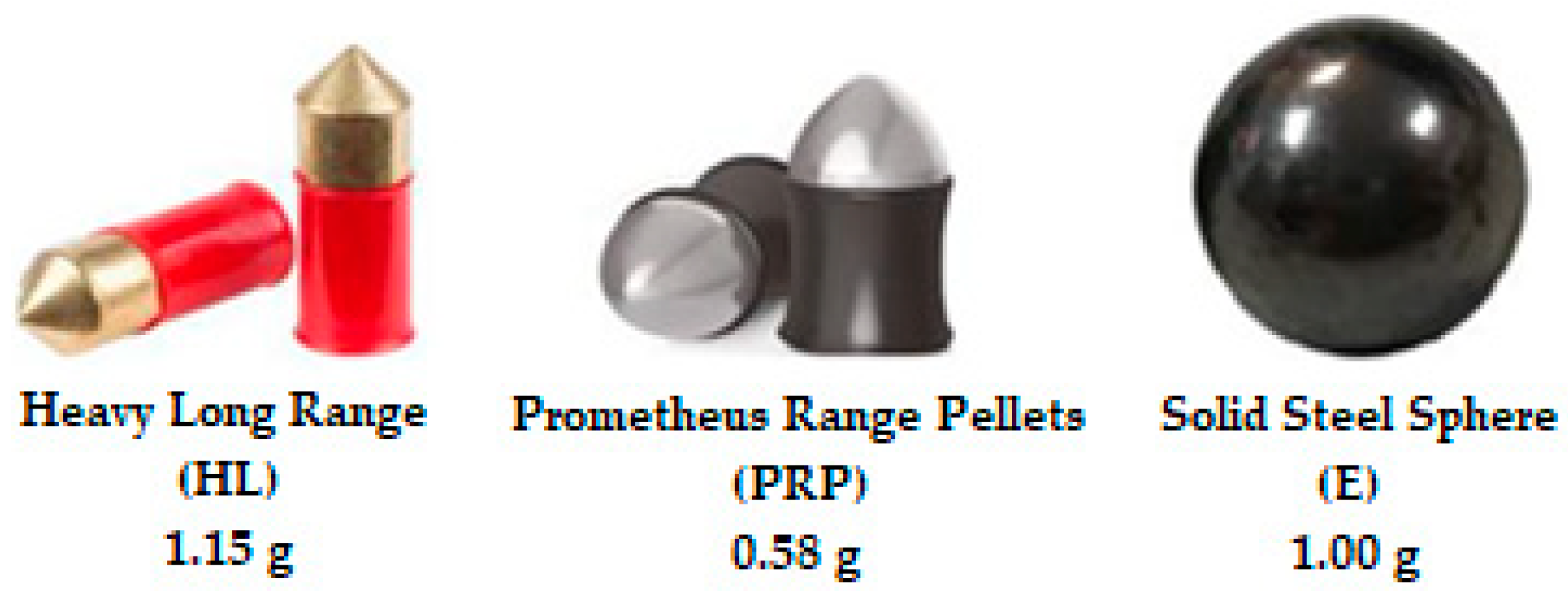
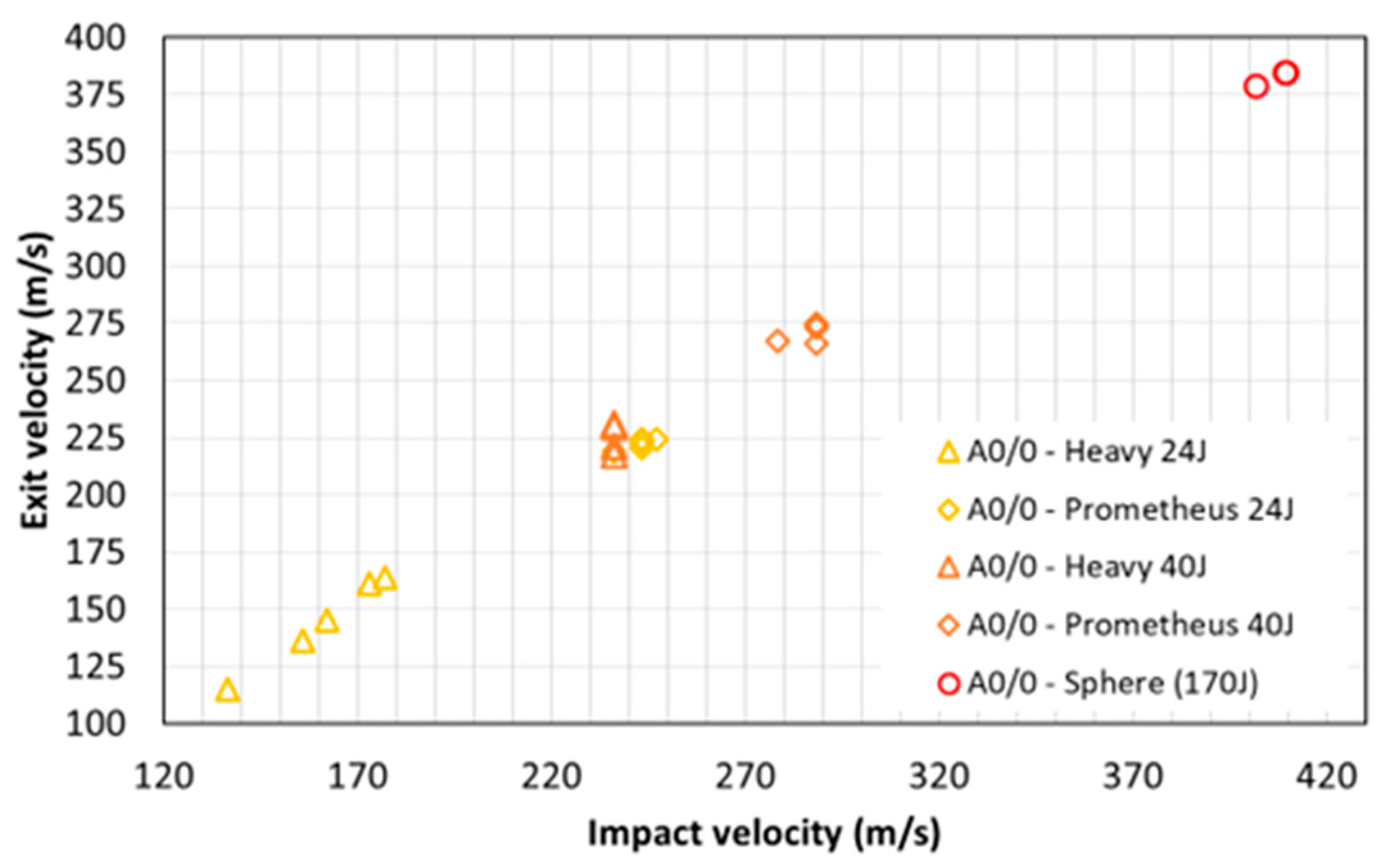
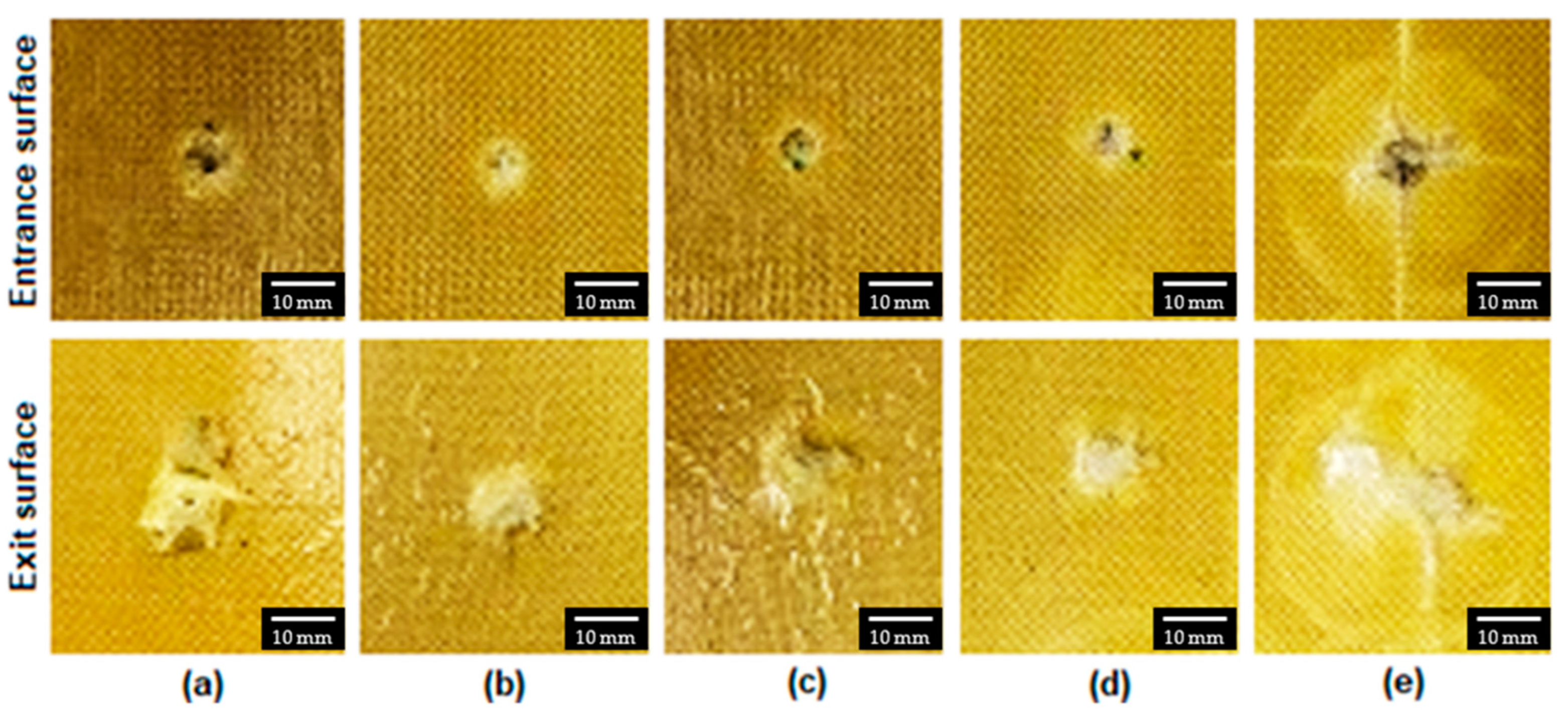
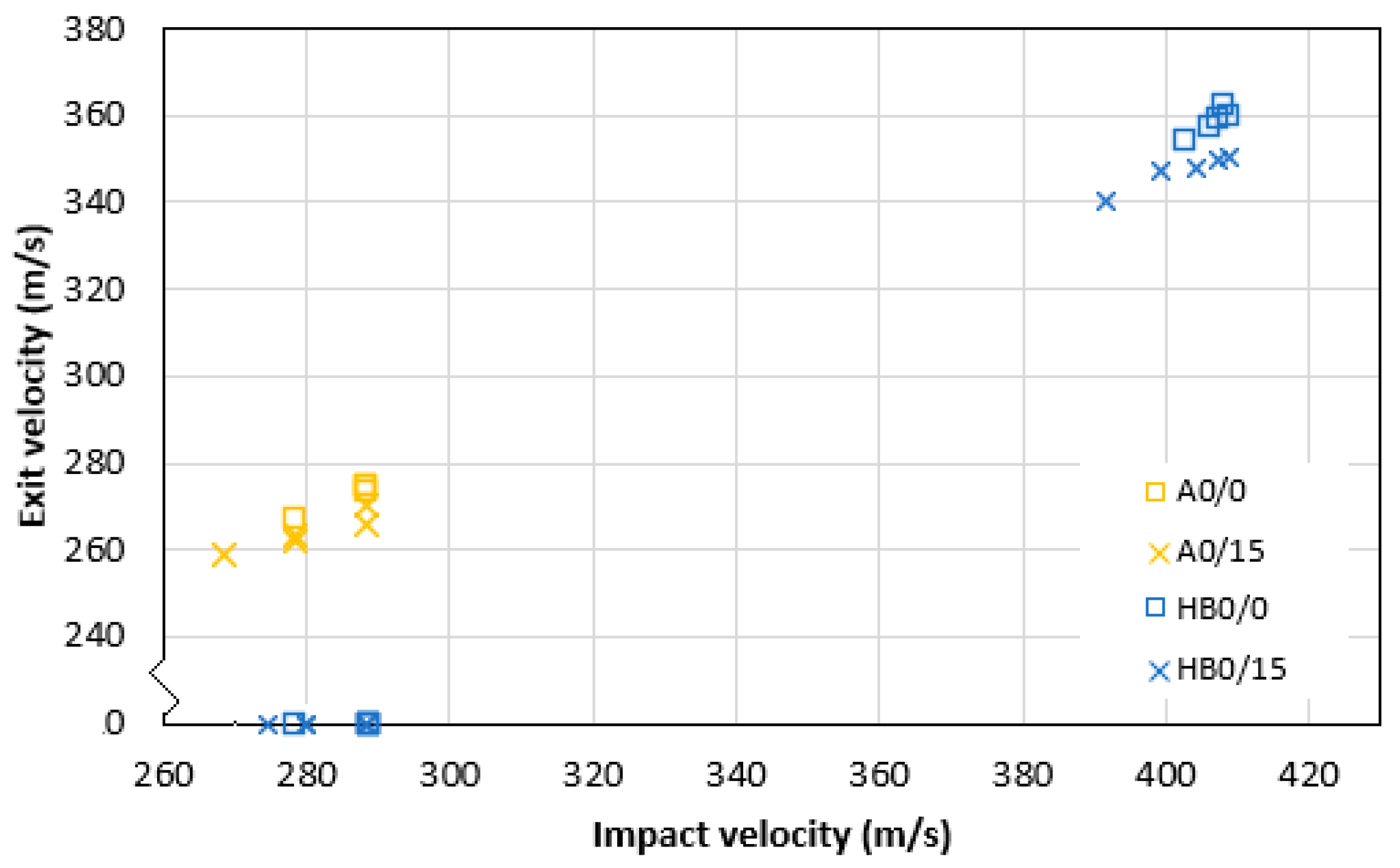
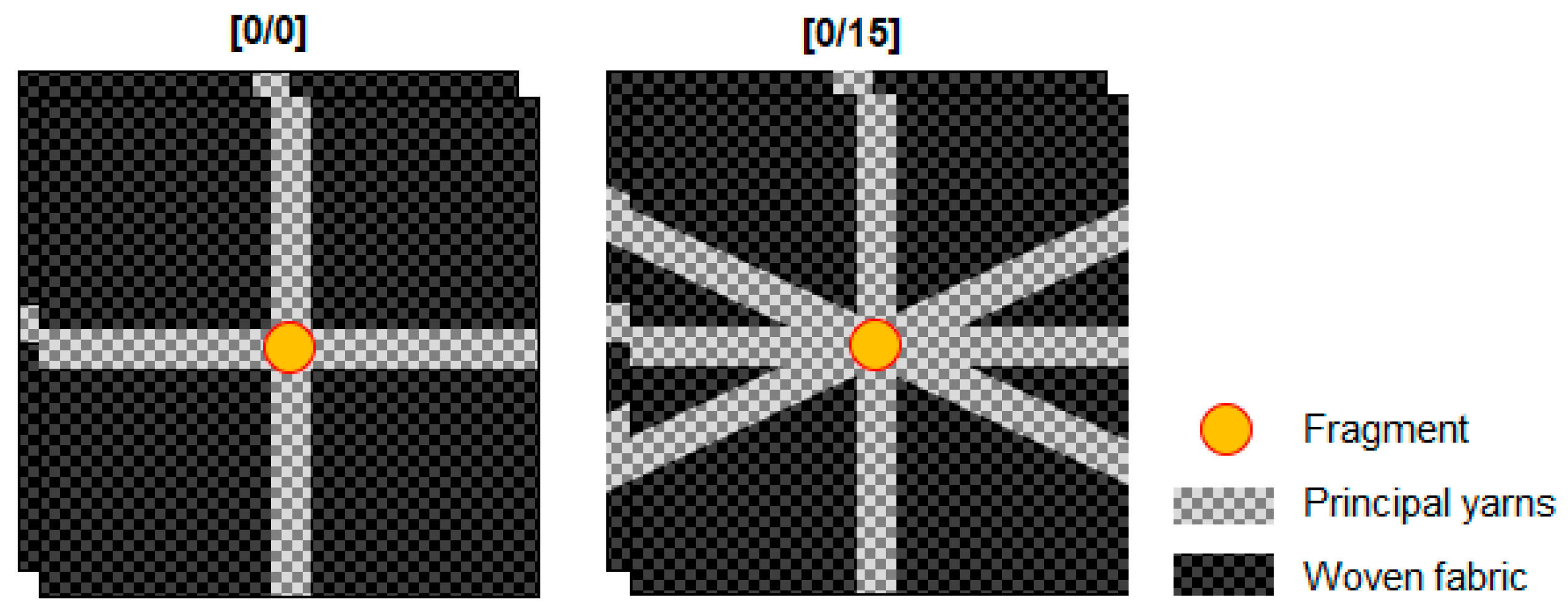

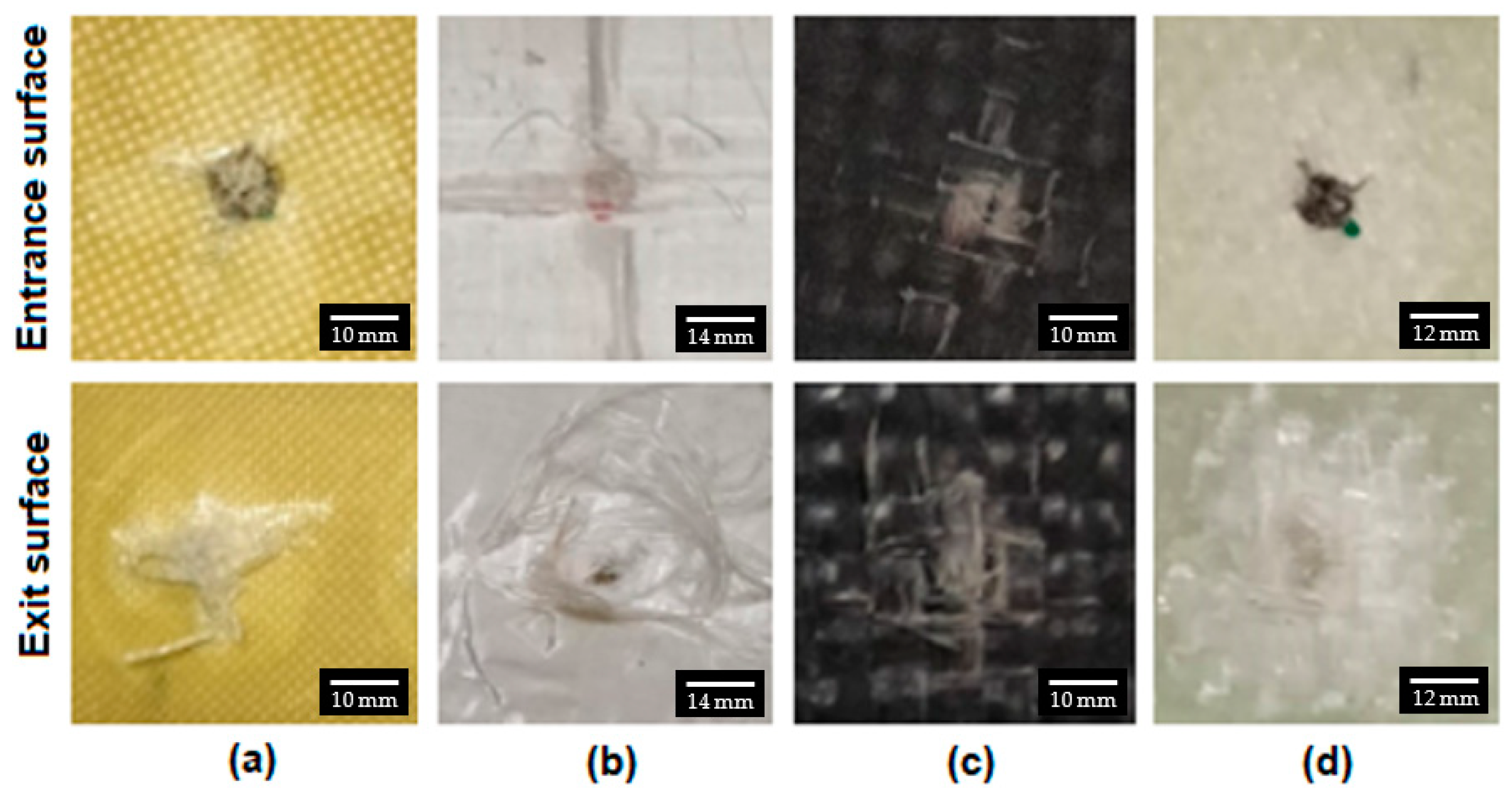
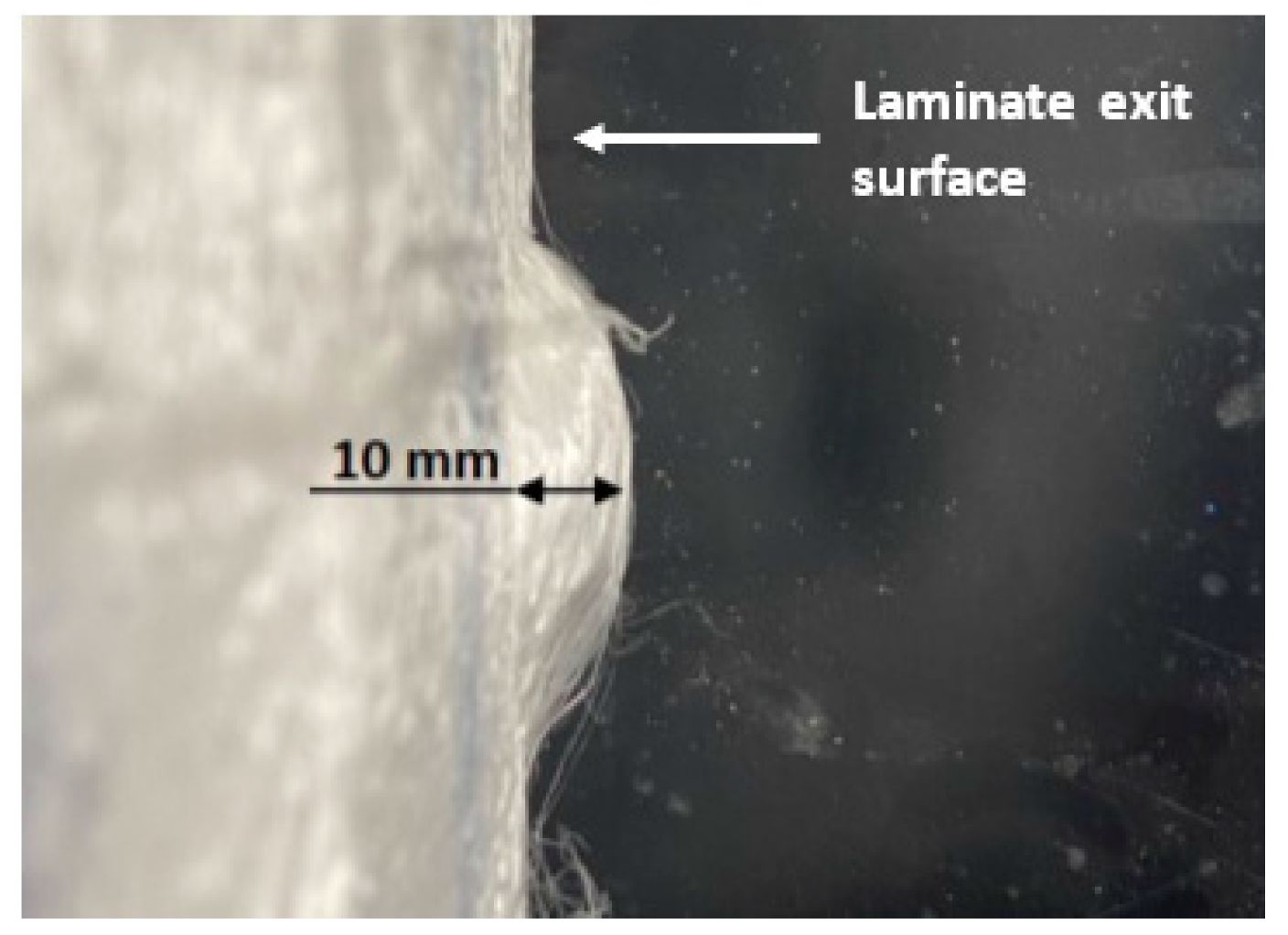
| Properties | Symbol | Units | E-Glass | S-Glass | Aramid | UHMWPE |
|---|---|---|---|---|---|---|
| Density | ρ | kg/m3 | 2119 | 2009 | 1320 | 960 |
| Areal density | g/m2 | 300 | 815 | 80 | 255 | |
| Young’s Modulus | E1 | GPa | 34.62 | 24.76 | 28.89 | 34.25 |
| E2 | 34.62 | 24.67 | 28.89 | 1.2 | ||
| Poisson’s ratio | ʋ12 | 0.29 | 0.18 | 0.18 | 0.013 | |
| Modulus of rigidity | G21 | GPa | 5 | 2.79 | 2.12 | 0.548 |
| G22 | 5.5 | 2.79 | 2.12 | 0.548 | ||
| Tensile strength | σT1 | MPa | 363 | 471.79 | 307 | 1250 |
| σT2 | 363 | 471.79 | 307 | 1250 | ||
| Compressive strength | σC1 | MPa | 409 | - | 94.39 | 1900 |
| σC2 | 92.2 | - | 112.66 | 1900 | ||
| Breaking strength | σr1 | MPa | 355 | 342.87 | 299.17 | - |
| σr2 | 355 | 342.87 | 299.17 | - | ||
| Elongation at break | ε | % | 1.53 | 2.76 | 1.5 | - |
| Sample | Orientation | Reference | Resin Mass Fraction (%) | Laminate Thickness (mm) | Number of Layers |
|---|---|---|---|---|---|
| Aramid | L0/0 | A0/0 | 29 | 1.14 | 12 |
| L0/15 | A0/15 | 28 | 1.09 | 12 | |
| HB 24 | L0/0 | HB0/0 | - | 1.16 | 4 |
| L0/15 | HB0/15 | - | 1.10 | 4 | |
| E-glass | L0/15 | E0/15 | 31 | 1.13 | 6 |
| S-glass | L0/15 | S0/15 | 33 | 1.22 | 2 |
| Sample | Projectile | Projectile Diameter (mm) | Impact Energy (J) | Front Face Impact Hole (mm2) | Back Face Areal Damage (mm2) |
|---|---|---|---|---|---|
| Aramid L0/0 | HL | 5.5 | 24 | 55.2 ± 0.03 | 150.1 ± 2.25 |
| 40 | 57.2 ± 0.01 | 113.8 ± 0.54 | |||
| PRP | 5.5 | 24 | 56.2 ± 0.01 | 115.7 ± 1.43 | |
| 40 | 55.2 ± 0.02 | 100.0 ± 0.62 | |||
| Solid Sphere | 7.9 | 160 | 78.9 ± 0.01 | 1500.2 ± 9.71 |
Disclaimer/Publisher’s Note: The statements, opinions and data contained in all publications are solely those of the individual author(s) and contributor(s) and not of MDPI and/or the editor(s). MDPI and/or the editor(s) disclaim responsibility for any injury to people or property resulting from any ideas, methods, instructions or products referred to in the content. |
© 2023 by the authors. Licensee MDPI, Basel, Switzerland. This article is an open access article distributed under the terms and conditions of the Creative Commons Attribution (CC BY) license (https://creativecommons.org/licenses/by/4.0/).
Share and Cite
Barros, D.; Mota, C.; Bessa, J.; Cunha, F.; Rosa, P.; Fangueiro, R. Blast Fragment Impact of Angle-Ply Composite Structures for Buildings Wall Protection. Buildings 2023, 13, 1959. https://doi.org/10.3390/buildings13081959
Barros D, Mota C, Bessa J, Cunha F, Rosa P, Fangueiro R. Blast Fragment Impact of Angle-Ply Composite Structures for Buildings Wall Protection. Buildings. 2023; 13(8):1959. https://doi.org/10.3390/buildings13081959
Chicago/Turabian StyleBarros, Daniel, Carlos Mota, João Bessa, Fernando Cunha, Pedro Rosa, and Raul Fangueiro. 2023. "Blast Fragment Impact of Angle-Ply Composite Structures for Buildings Wall Protection" Buildings 13, no. 8: 1959. https://doi.org/10.3390/buildings13081959








